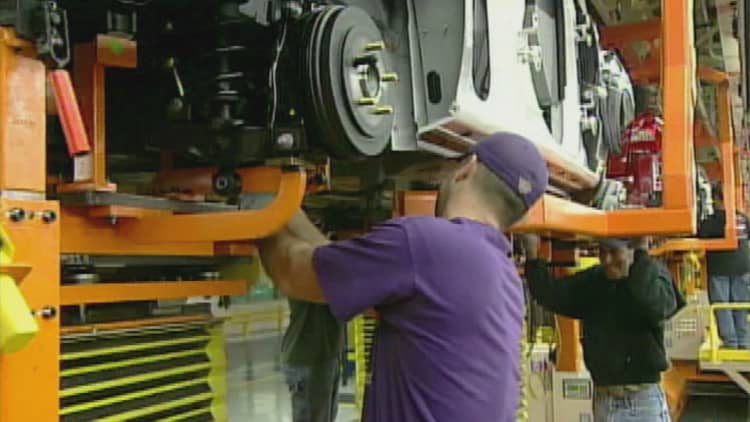
Philadonna Wade's story plays out across middle America on a daily basis but is seldom told. It's the story of the working poor who labor in tough jobs — like Wade's position as an assembler for a Ford Motor plant — that don't pay enough to keep them off public assistance.
In fact, fully 1 in 3 Americans who work in the manufacturing sector are receiving some form of public assistance, according to a study released this week by the UC Berkeley Center for Labor Research and Education. Of those who came to their positions through temp agencies, a category in which Wade falls, half are on some type of safety net program.
It's not that Wade wants to be on food stamps and Medicaid, among other programs, it's that the mother of four has no choice.
"I absolutely hate being on public assistance," she said in an interview. "You constantly have people judging you."
Behind the government jobs reports that show an average 232,000 new positions created over the past 12 months, and the ensuing White House cheerleading about the strength of the economy, are people like Wade who languish at manufacturing jobs that are supposed to be the backbone of U.S industry but instead are poverty traps with little hope of escape.
The UC Berkeley study found that low wages, and not inadequate hours, are the primary culprit for why so many manufacturing workers require public assistance to survive.
"Historically, blue collar jobs in manufacturing provided opportunities for workers without a college education to earn a decent living," said the study from researchers Ken Jacobs, Zohar Perla, Ian Perry and Dave Graham-Squire. "For many manufacturing jobs, this is no longer true."
Wade lives in Lorain, Ohio, a blue-collar town on Lake Erie where annual income of $32,494 is well below the state average of $48,081 and the unemployment rate of 6.5 percent is above the state's 5.1 percent and well above the national average of 5 percent. As a state, Ohio ranks near the bottom of the list in terms of the family participation rate in welfare programs for production workers, with 24 percent of families participating against the national average of 34 percent.
Manufacturing workers in the safety net
| State | Total family participation for mfg workers (%) |
|---|---|
| Mississippi | 59 |
| Georgia | 47 |
| California | 45 |
| Texas | 42 |
| Arkansas | 41 |
| Tennessee | 40 |
| Alabama | 39 |
| New York | 39 |
| North Carolina | 39 |
| South Carolina | 39 |
| All states | 34 |
Source: Source: UC Berkeley Center for Labor Research and Education
The most recent Labor Department figures show that the median wage for production jobs is $15.51 an hour, or barely above the $15 an hour minimum wage figure that is the goal of the nationwide "Fight for 15" campaign. The unemployment rate for production-related jobs is 5.8 percent overall and considerably higher for women, at 8.2 percent.
For Wade, a 31-year-old single mother who works as an assembler at the Detroit Chassis plant in Avon, Ohio, having work is a good thing but the low wages are rough. She makes just $9.50 an hour and some weeks doesn't even get a full 40 hours.
"You look at what you're supposed to be making and you look at what you are making. It's sad," she said. "I was promised a lot of things. ... You think this is going to happen, I'm finally going to be able to move out of the projects and get off food stamps. ... I feel like a bum, but I know I'm not a bum."
U.S. companies trying to save money have been hiring more and more workers from temp agencies because they can pay lower wages and offer limited benefits. In fact, the Detroit Chassis plant recently avoided a strike narrowly when it allowed temp workers to join the United Auto Workers union.
The public costs to support frontline manufacturing workers are growing. From 2009-2013 alone, the federal and state governments spent $10.2 billion on "safety net" programs for the sector, according to the study. On a nationwide basis across all sectors, there are 44.4 million Americans on the Supplemental Nutrition Assistance Program, or food stamps program.
Though Wade knows she's doing what she has to do to take care of her kids, she sees the stigma attached to social programs.
"I work hard to take care of my kids, but at the end of the day I feel like a bum when I use my food stamp card or Medicaid," she said. "I just don't want to feel that way. I want to be able to move on from this point in my life. I feel like I'm being punished. I did it to myself, I guess. But I want out."


